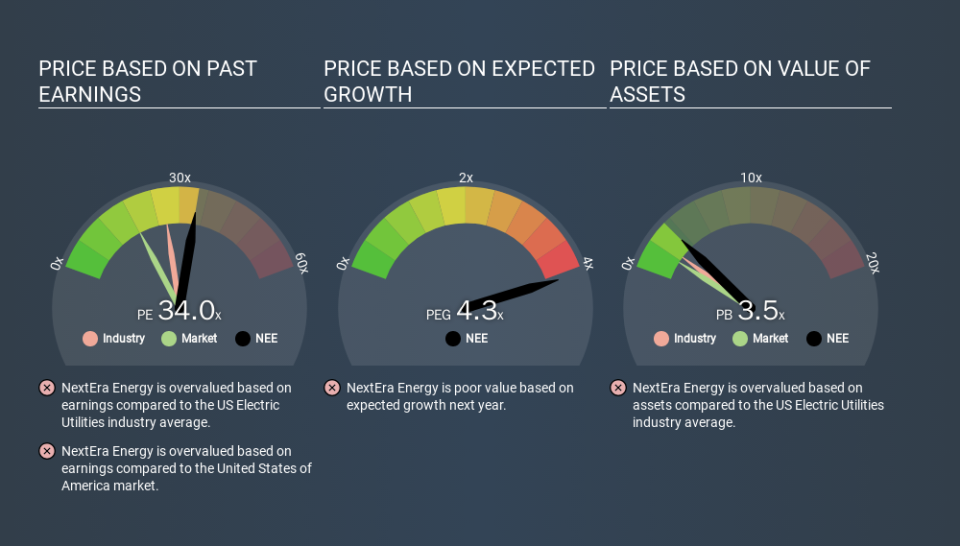What Does NextEra Energy, Inc.'s (NYSE:NEE) P/E Ratio Tell You?

This article is written for those who want to get better at using price to earnings ratios (P/E ratios). We'll show how you can use NextEra Energy, Inc.'s (NYSE:NEE) P/E ratio to inform your assessment of the investment opportunity. What is NextEra Energy's P/E ratio? Well, based on the last twelve months it is 34.04. That is equivalent to an earnings yield of about 2.9%.
See our latest analysis for NextEra Energy
How Do I Calculate NextEra Energy's Price To Earnings Ratio?
The formula for P/E is:
Price to Earnings Ratio = Price per Share ÷ Earnings per Share (EPS)
Or for NextEra Energy:
P/E of 34.04 = USD264.54 ÷ USD7.77 (Based on the trailing twelve months to December 2019.)
Is A High Price-to-Earnings Ratio Good?
A higher P/E ratio means that investors are paying a higher price for each USD1 of company earnings. That isn't necessarily good or bad, but a high P/E implies relatively high expectations of what a company can achieve in the future.
Does NextEra Energy Have A Relatively High Or Low P/E For Its Industry?
We can get an indication of market expectations by looking at the P/E ratio. The image below shows that NextEra Energy has a higher P/E than the average (26.2) P/E for companies in the electric utilities industry.
Its relatively high P/E ratio indicates that NextEra Energy shareholders think it will perform better than other companies in its industry classification. Shareholders are clearly optimistic, but the future is always uncertain. So investors should always consider the P/E ratio alongside other factors, such as whether company directors have been buying shares.
How Growth Rates Impact P/E Ratios
P/E ratios primarily reflect market expectations around earnings growth rates. When earnings grow, the 'E' increases, over time. And in that case, the P/E ratio itself will drop rather quickly. And as that P/E ratio drops, the company will look cheap, unless its share price increases.
NextEra Energy saw earnings per share decrease by 45% last year. But over the longer term (5 years) earnings per share have increased by 6.5%.
Don't Forget: The P/E Does Not Account For Debt or Bank Deposits
Don't forget that the P/E ratio considers market capitalization. That means it doesn't take debt or cash into account. In theory, a company can lower its future P/E ratio by using cash or debt to invest in growth.
Spending on growth might be good or bad a few years later, but the point is that the P/E ratio does not account for the option (or lack thereof).
NextEra Energy's Balance Sheet
Net debt is 32% of NextEra Energy's market cap. You'd want to be aware of this fact, but it doesn't bother us.
The Verdict On NextEra Energy's P/E Ratio
NextEra Energy's P/E is 34.0 which is above average (18.2) in its market. With some debt but no EPS growth last year, the market has high expectations of future profits.
Investors have an opportunity when market expectations about a stock are wrong. As value investor Benjamin Graham famously said, 'In the short run, the market is a voting machine but in the long run, it is a weighing machine. So this free visual report on analyst forecasts could hold the key to an excellent investment decision.
Of course, you might find a fantastic investment by looking at a few good candidates. So take a peek at this free list of companies with modest (or no) debt, trading on a P/E below 20.
If you spot an error that warrants correction, please contact the editor at editorial-team@simplywallst.com. This article by Simply Wall St is general in nature. It does not constitute a recommendation to buy or sell any stock, and does not take account of your objectives, or your financial situation. Simply Wall St has no position in the stocks mentioned.
We aim to bring you long-term focused research analysis driven by fundamental data. Note that our analysis may not factor in the latest price-sensitive company announcements or qualitative material. Thank you for reading.



